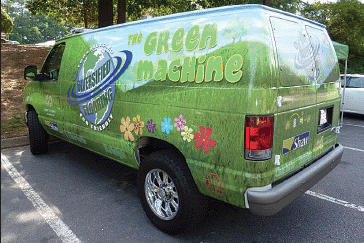By George Davies Assistant director of marketing, Shaw Industries
Environmental stewardship takes many forms, and some products and processes are, quite simply, greener than others. However, virtually any attempt to make our world a better place is to be commended, so let’s take a look at some of today’s common practices in manufacturing:
• Conservation of natural resources. Finding ways to minimize the use of fossil fuels, using alternative energy sources and reducing water consumption are all responsible ways to conserve natural resources.
Many companies have made great strides in reducing energy and water use. For example, Shaw has built a waste-to-energy facility that converts post-industrial carpet and wood waste into steam energy and another carpet-to-energy operation that will be fueled by postconsumer and post-industrial carpet waste.
• Waste reduction. Reducing waste means less to the landfill. Recycling and more efficient manufacturing processes contribute to waste reduction. Many flooring companies have aggressive goals for landfill avoidance and are committed to specific percentage reductions in targeted years.
• Corporate social responsibility. Being a responsible corporate citizen is an integral part of environmental stewardship. The health and safety of a company’s employees and the welfare of the communities in which people live and work should always be part of any business’s overall commitment to improving the lives of those around us.
Many companies and their employees participate in mentoring and afterschool programs, fund-raising activities, blood donations and food drives, all in an effort to give back to their communities. There’s really nothing greener than providing assistance to those in need.
• Recycling. One of the most popular and widely used green initiatives, recycling is performed on many different levels. From employees recycling plastic, paper and aluminum products to large-scale recycling of manufacturing and postconsumer waste, recycling projects are prevalent in the flooring industry and many others as well.
Perhaps the greenest form of recycling is what is referred to as cradle-to-cradle recycling. Mimicking nature’s closed-loop pattern of recycling and renewal, cradle-to-cradle production means products can be collected and returned to manufacturing of the original product again and again. Type 6 nylon is an example of a cradle-to-cradle carpet fiber that can be recycled into the building block of new nylon fiber. Some carpet cushions and backings can also be recycled back into themselves.
• Green products. Flooring manufacturers have led the way in developing environmentally responsible products: carpet fibers that are cradle-to-cradle recyclable, carpet fibers that are made from other products, bio-based fibers and carpet cushion, and hardwood styles made with recycled components and post-industrial waste.
Our products, processes, and programs have all contributed to making the flooring industry one of the greenest businesses in the world.
Environmental stewardship takes many forms, and some products and processes are, quite simply, greener than others. However, virtually any attempt to make our world a better place is to be commended, so let’s take a look at some of today’s common practices in manufacturing:
• Conservation of natural resources. Finding ways to minimize the use of fossil fuels, using alternative energy sources and reducing water consumption are all responsible ways to conserve natural resources.
Many companies have made great strides in reducing energy and water use. For example, Shaw has built a waste-to-energy facility that converts post-industrial carpet and wood waste into steam energy and another carpet-to-energy operation that will be fueled by postconsumer and post-industrial carpet waste.
• Waste reduction. Reducing waste means less to the landfill. Recycling and more efficient manufacturing processes contribute to waste reduction. Many flooring companies have aggressive goals for landfill avoidance and are committed to specific percentage reductions in targeted years.
• Corporate social responsibility. Being a responsible corporate citizen is an integral part of environmental stewardship. The health and safety of a company’s employees and the welfare of the communities in which people live and work should always be part of any business’s overall commitment to improving the lives of those around us.
Many companies and their employees participate in mentoring and afterschool programs, fund-raising activities, blood donations and food drives, all in an effort to give back to their communities. There’s really nothing greener than providing assistance to those in need.
• Recycling. One of the most popular and widely used green initiatives, recycling is performed on many different levels. From employees recycling plastic, paper and aluminum products to large-scale recycling of manufacturing and postconsumer waste, recycling projects are prevalent in the flooring industry and many others as well.
Perhaps the greenest form of recycling is what is referred to as cradle-to-cradle recycling. Mimicking nature’s closed-loop pattern of recycling and renewal, cradle-to-cradle production means products can be collected and returned to manufacturing of the original product again and again. Type 6 nylon is an example of a cradle-to-cradle carpet fiber that can be recycled into the building block of new nylon fiber. Some carpet cushions and backings can also be recycled back into themselves.
• Green products. Flooring manufacturers have led the way in developing environmentally responsible products: carpet fibers that are cradle-to-cradle recyclable, carpet fibers that are made from other products, bio-based fibers and carpet cushion, and hardwood styles made with recycled components and post-industrial waste.
Our products, processes, and programs have all contributed to making the flooring industry one of the greenest businesses in the world.
 |